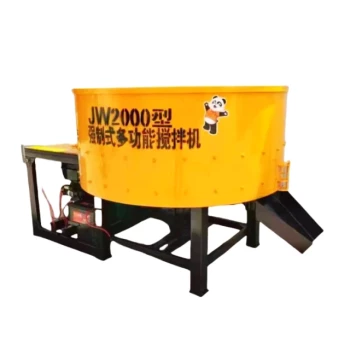The order of loading materials in a cement mixer is crucial for achieving a homogeneous, high-quality concrete mix. Proper sequencing ensures even coating of aggregates, prevents clumping, and optimizes water distribution. Starting with half the water prevents cement from sticking to the drum, while gradual addition of remaining water fine-tunes consistency. This method aligns with batching accuracy requirements to meet strength and durability specifications.
Key Points Explained:
-
Preventing Cement Adhesion
- Loading half the water first creates a lubricating layer inside the drum, reducing the risk of dry cement sticking to surfaces.
- Stuck cement can lead to uneven mixing, wasted material, and inconsistent batch quality.
-
Aggregate Coating Efficiency
- Adding aggregates (e.g., gravel) after initial water ensures they are evenly coated before cement is introduced.
- This step minimizes voids in the mix, enhancing structural integrity and reducing permeability in the final concrete.
-
Sequential Cement and Sand Addition
- Cement is added post-aggregates to bind uniformly with the pre-wetted materials.
- Sand follows to fill gaps between larger aggregates, creating a smooth blend and improving workability.
-
Controlled Water Integration
- The remaining water is added gradually to adjust consistency without oversaturation.
- Excess water can weaken concrete strength, while too little hampers workability and curing.
-
Batching Accuracy
- The prescribed order supports precise adherence to mix designs, ensuring technical requirements (e.g., compressive strength) are met.
- Weighing materials before loading further guarantees formulation accuracy.
-
Operational Efficiency
- Batch mixing without overloading the drum prevents uneven rotation and motor strain.
- Proper sequencing reduces mixing time and energy consumption while improving output quality.
By following this workflow, contractors achieve durable, uniform concrete mixes tailored to project specifications—showcasing how meticulous material handling underpins infrastructure reliability.
Summary Table:
| Step | Purpose | Outcome |
|---|---|---|
| 1. Half Water First | Prevents cement adhesion to drum | Reduces waste, ensures even mixing |
| 2. Add Aggregates | Coats gravel/sand before cement | Minimizes voids, enhances structural integrity |
| 3. Cement + Sand | Binds uniformly with pre-wetted materials | Smooth blend, improved workability |
| 4. Gradual Water | Adjusts consistency without oversaturation | Balanced strength and workability |
| 5. Batching Accuracy | Ensures adherence to mix designs | Meets compressive strength and durability specs |
| 6. Avoid Overloading | Prevents motor strain and uneven rotation | Saves energy, reduces mixing time |
Upgrade your concrete mixing process with GARLWAY’s reliable equipment!
Our cement mixers are engineered for precision batching and durability, helping construction teams achieve consistent, high-quality results. Contact us today to find the ideal mixer for your project needs.
Why choose GARLWAY?
- Tailored Solutions: Customizable mixers for diverse project scales.
- Efficiency-Driven Design: Reduce waste and energy costs.
- Global Support: Trusted by contractors worldwide.
Related Products
- HZS75 Concrete Batching Plant Cement Mixer Price Concrete Mixer Bunnings Mixing Plant
- Concrete Cement Mixer Machine Drum Mixer for Construction
- Auto Concrete Cement Mixer Machine New
- JZC1000 Industrial Concrete Mixer Machine Cement Mixer Price
- HZS25 Best Cement Mixer for Quick Mix Concrete at Bunnings
People Also Ask
- How do I choose a cement mixer? Find the Perfect Mix for Your Project
- How much does a batching plant cost? Pricing Guide for Concrete Mixing Plants
- Do you put water or cement in a cement mixer first? The Right Order for Perfect Concrete
- What can you mix in a cement mixer? Discover Its Versatile Uses
- How to start a concrete plant business? A Step-by-Step Guide to Building Your Construction Materials Venture
















